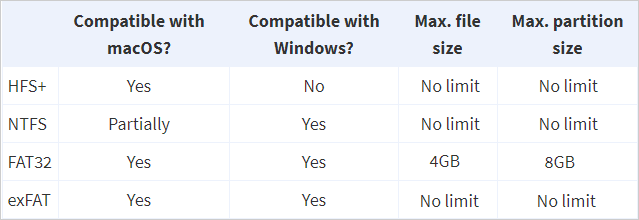

- DRIVE FORMAT FOR BOTH MAC AND WINDOWS MAC OS X
- DRIVE FORMAT FOR BOTH MAC AND WINDOWS INSTALL
- DRIVE FORMAT FOR BOTH MAC AND WINDOWS SOFTWARE
- DRIVE FORMAT FOR BOTH MAC AND WINDOWS WINDOWS 7
This volume format accommodates Mac OS X and Mac files the best.
DRIVE FORMAT FOR BOTH MAC AND WINDOWS INSTALL
Give the drive one HFS+J (Mac OS Extended, Journaled) partition large enough to install Mac OS X onto (10GB+).Also avoid Apple Partition Map, which Windows machines would have no clue about. Avoid Master Boot Record, which Intel Macs can't boot from. Reformat the drive, using the GUID Partition Table (GPT) as the low-level partition table format.If you want something that both machines / OSes can read a write, and that can act as an emergency boot drive for either machine, do this:
DRIVE FORMAT FOR BOTH MAC AND WINDOWS SOFTWARE
Using additional software like this will probably create a performance hit, but how noticeable it is depends on your usage pattern. You should choose the filesystem that you plan on using most frequently so that it is as fast as possible and then reformat the disk accordingly. On the Mac, this can be accomplished using add-ons related to the MacFuse project. Look at additional software which will allow for either NTFS or HFS+ to be read on OS X and Windows respectively. This could be used to move data between the Mac and the Windows machine, but would suffer from all the same FAT32 issues mentioned above.

In addition to limitation to file sizes < 4 GB, you also lose a lot of nice features on HFS+ such as permissions and journalling.Ĭreate a FAT32 partition on the disk along side the existing HFS+ partition. Reformat the disk to FAT32, which ( as suggested by Michael Sturm) is the lowest common denominator in file systems between OS X and Windows. This file system type is not natively supported by Windows, which is why the disk will not mount when you plug it into your laptop. If it is Mac OS Extended or a something similar then your disk is using the HFS+ file system, which is the default for OS X. the name you see in your file tree when the disk mounts under OS X) what do you see for the Format at the bottom of the window? By this point in time, most computers you encounter will work fine with exFAT.If you open the Disk Utility application on your Mac with the disk connected, you should be able to see it in the list of disks on the left hand column of the Disk Utility window. You would not be able to use this disk for long HD videos and large disk images, for example.
DRIVE FORMAT FOR BOTH MAC AND WINDOWS WINDOWS 7
Plug the disk into a Windows Vista SP1 or Windows 7 computer.I will leave Windows instructions below for the benefit of Windows users. Mac instructions above will now work for exFAT. It appears the issue has since been fixed and disks formatted exFAT on OS X 10.7 (Lion) and 10.8 (Mountain Lion) are working with Windows. Update: At the time of the original posting in 2011, there were some problems getting a Mac formatted exFAT drive working with Windows, it had trouble recognizing those drives.

To format the drive to work with both platforms you will need use a Windows computer to format the disk as exFAT. You must have Mac OS X 10.6.5 or newer, and PCs need to be Windows Vista SP1, Windows 7, or newer.Īlthough it is possible to format a drive as exFAT from Disk Utility on the Mac, that drive will not work with Windows PCs, and that’s not what we’re after. The erase option deletes all the data that was in the drive.Ĭons: Not compatible with older operating systems.


 0 kommentar(er)
0 kommentar(er)
